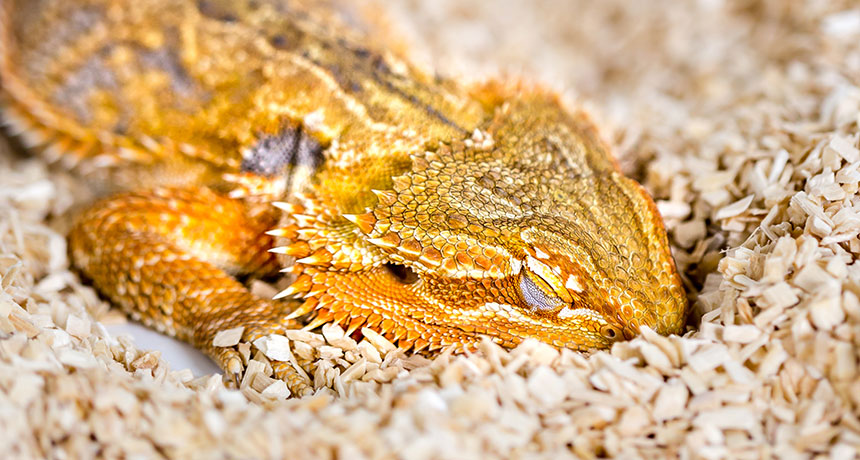
CATCHING Z’S While sleeping, this Australian dragon (Pogona vitticeps) shows brain wave patterns similar to those of slumbering birds and mammals.
Stephan Junek/MPI for Brain Research
- More than 2 years ago
Lizards might snooze like humans do.
Sleeping lizards appear to share distinctive brain activity patterns with sleeping birds and mammals, researchers report in the April 29 Science. If true, the results suggest that human sleep patterns evolved by around 300 million years ago in a common ancestor of birds, mammals and reptiles.
During sleep, mammal and bird brains alternate between two states of activity. In deep, slow-wave sleep, recordings of the brain’s electrical activity show sparse bursts of big, slow waves. During rapid eye movement, or REM, sleep, brain waves appear small and fast, like those of an awake brain. REM sleep is usually accompanied by quickly twitching eyes.
“The prevailing view has been that REM and slow-wave sleep are limited to mammals and birds,” says study coauthor Gilles Laurent, a neuroscientist at the Max Planck Institute for Brain Research in Frankfurt. Many researchers think that birds and mammals separately evolved this similar sleep pattern, Laurent says. So when he and his colleagues monitored dozing Australian dragons (Pogona vitticeps), they were surprised to find familiar patterns.
“We saw this two-state sleep in the lizard, which we definitely did not expect,” says study coauthor Mark Shein-Idelson, also of the Max Planck Institute for Brain Research.
While exhibiting REM-like brain waves, the dragons’ eyes flicked, a convincing sign that lizards sleep like mammals, Shein-Idelson says. Probes implanted in the dragons’ brains revealed hundreds of cycles of alternating slow-wave–like and REM-like sleep each night. Lizards’ sleep cycles were simple and speedy, though — each around 80 seconds on average, compared with roughly a half hour in cats and up to an hour and a half in humans, Laurent says.
But some scientists say more evidence is required to prove that the dragons are truly experiencing two-state sleep.
“It is possible that the dragons were immobile with eyes closed — but awake,” says comparative sleep researcher John Lesku of La Trobe University in Melbourne, Australia. REM brain activity looks similar to that of an awake brain. Neuroscientist Niels Rattenborg of the Max Planck Institute for Ornithology in Seewiesen, Germany, points out that eye movements and limb twitching in REM sleep can also be hard to distinguish from brief awakenings. Additional evidence distinguishing between the two states — showing that it’s difficult to rouse a lizard during apparent REM sleep — would support the case that the dragons are truly snoozing, Rattenborg says.
Laurent says that slumbering lizards did show other signs of sleep, including reduced muscle activity and low heart rate, and could often be moved without waking. And the team observed gradual changes in brain wave patterns, such as increasing sleep-cycle length over the course of a night, which would be unexpected if the lizards were constantly waking up.
If lizards do experience REM and slow-wave sleep, two-state sleep probably stems from a common ancestor of all reptiles, birds and mammals, Laurent says. That small, lizardlike common ancestor lived some 320 million to 300 million years ago, he says, “at a time when the Earth’s continents formed a single landmass.”
An even older creature could be the true founder of two-state sleep, Laurent says. But to support this idea, researchers would need to find such sleep patterns in more distant relatives, such as fish or amphibians.
Such evolutionary insight from reptiles could benefit neuroscience, Lesku says. “By studying how brain rhythms evolved, we might better understand the function these rhythms play in different types of animals, including ourselves.”






